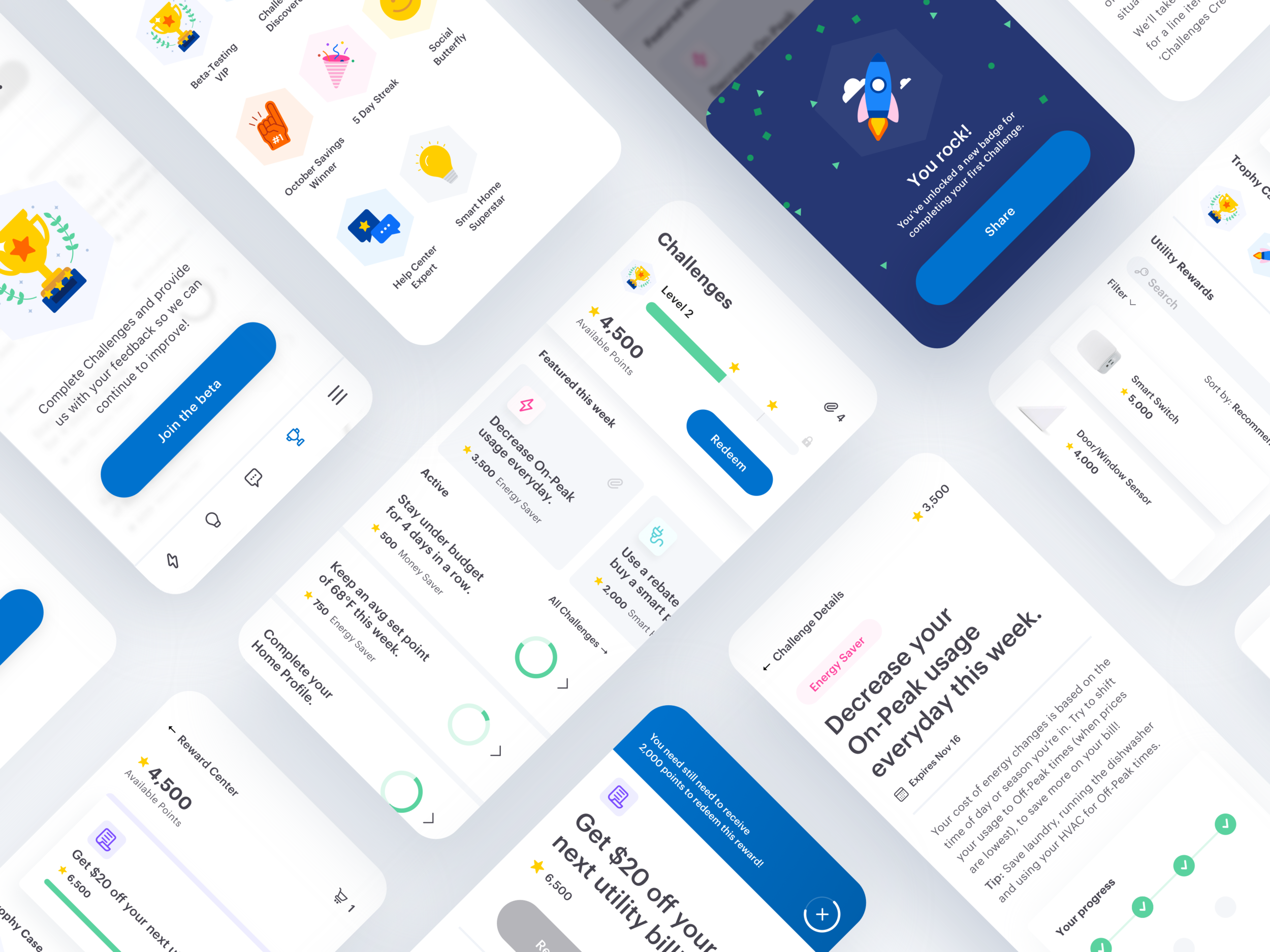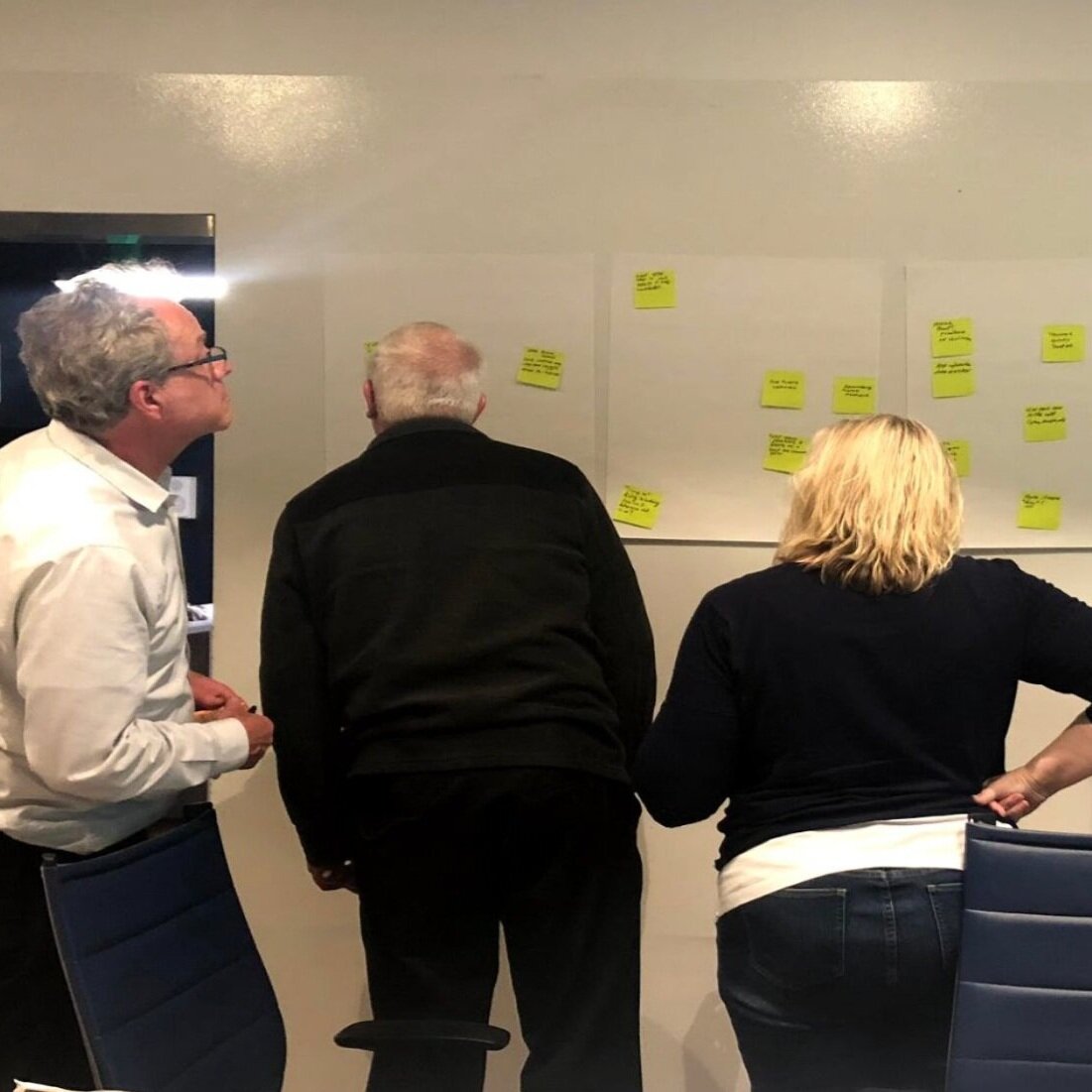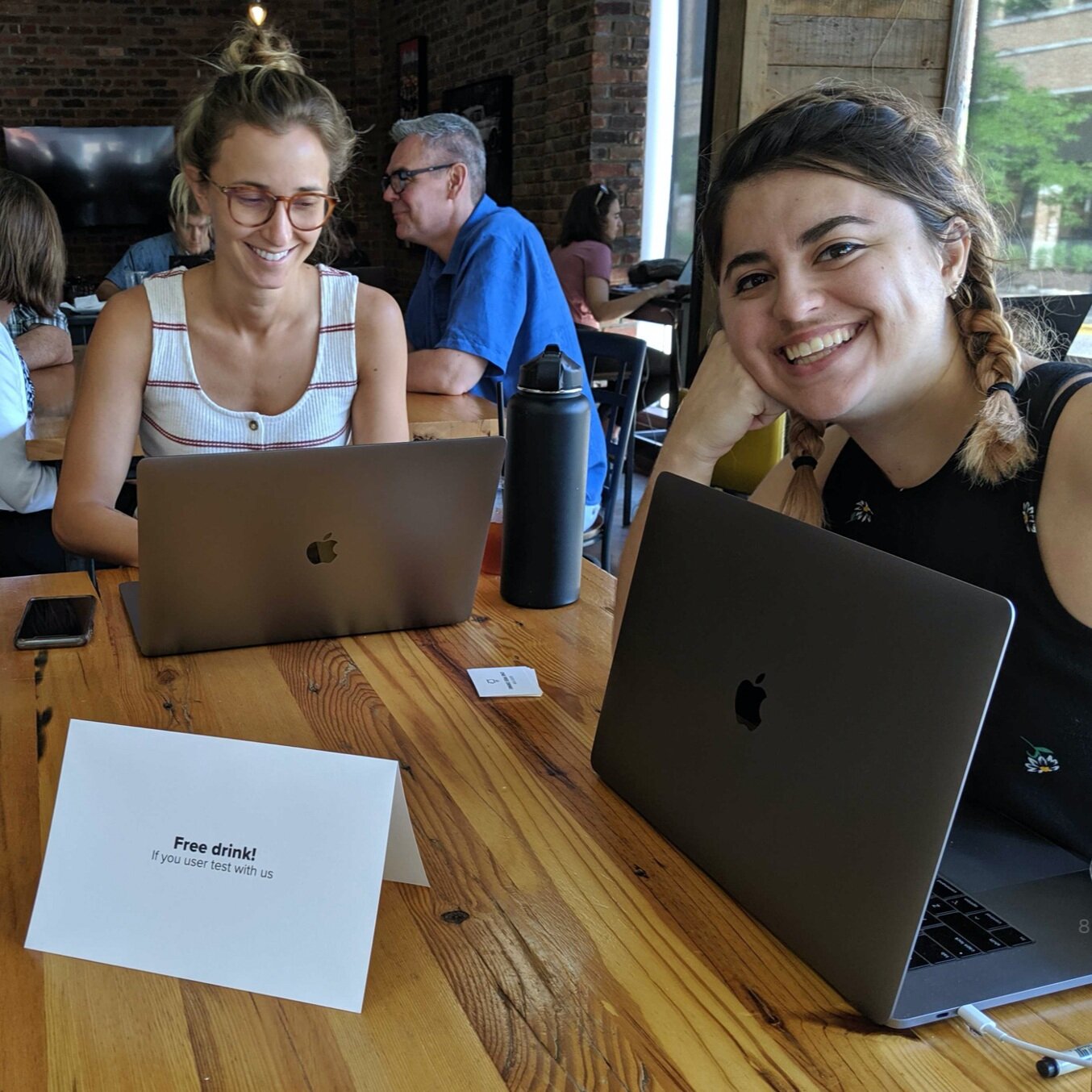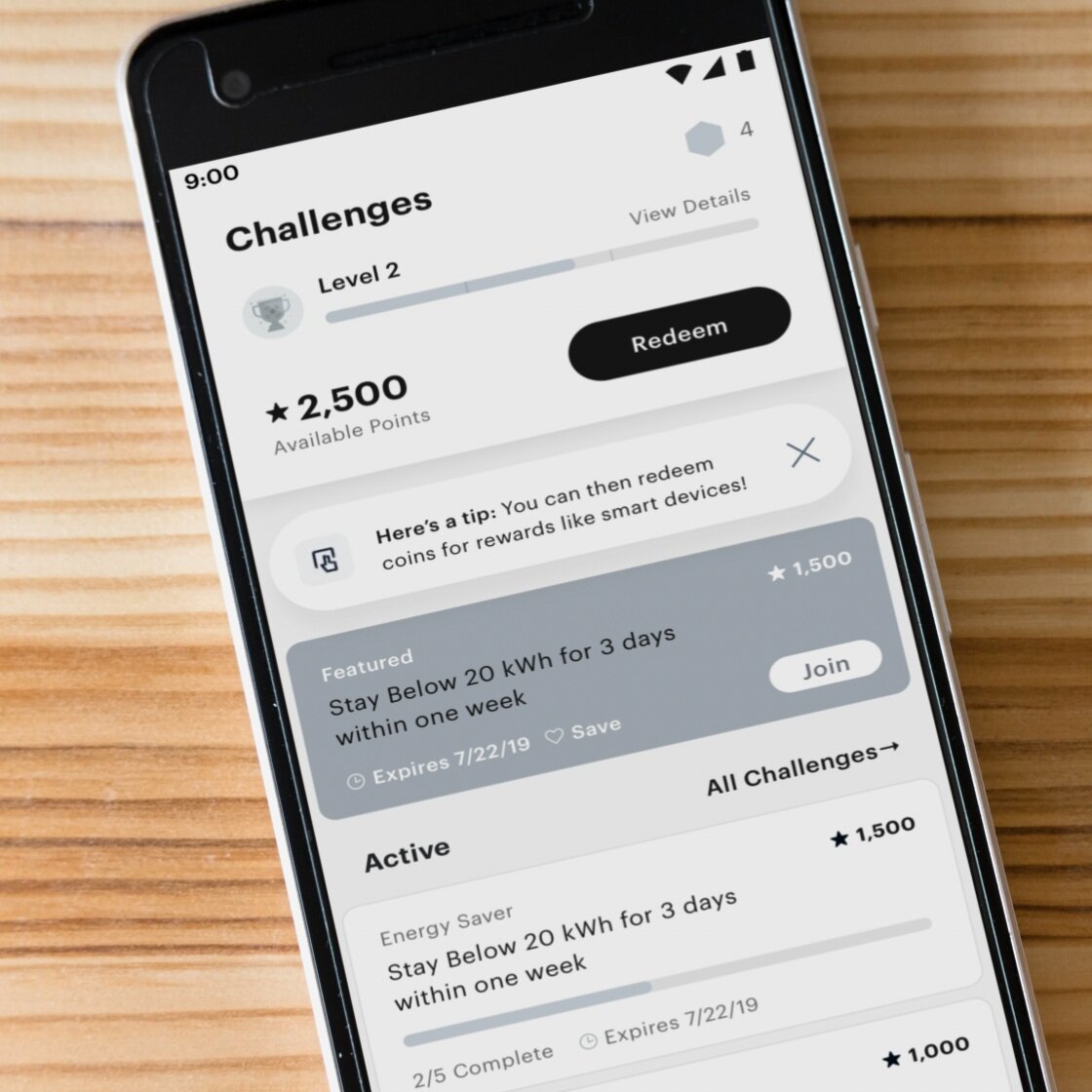Challenges System
The Behavior Change Engine (colloquially know as Challenges) utilizes a gamification system to motivate the user to achieve specific Energy Efficiency (EE) actions. Upon completion of tasks, the user receives both intrinsic and extrinsic rewards as a means to close the loop and increase continued use of the platform.
The current Challenges system gets less-than-favorable reviews, and the feature redesign is intended to help increase user engagement and ultimately drive energy saving behaviors.
Problem
We get angry customer reviews specifically directed at the current Challenges feature
As a core part of the platform, this experience is the least-used
Customer energy usage tends to increase over time
Hypothesis
There are currently no rewards offered
The system is not intuitive
Users feel tasks are seemingly pointless
Challenges lack personalization
There are no success states
App reliability and performance issues, such as challenges no longer populating
Goals
Us: Increase overall app engagement, get better reviews, and gain access to a measurable path towards specific actions/milestones
User: Save energy and money, be rewarded, and interact with gamified energy usage in their daily lives
Utility: Have more efficient users that participate in deeper engagement, as that has become a core performance metric for our largest commercialized customers over the past couple years
Success Metrics
Overall kWh reduction
Overall app engagement rate
Feature discoverability rate
Challenge attempt rate
Challenge completion rate
Feature retention rate
My roles
User Research
User Testing
Product Design
UX/UI
Cross-functional teams
Design
Product Mgmt
Voice of the Customer
Engineering (Mobile & Web)
Data Science
QA
External Research Consultants
Challenges
As we’ve never attempted gamification, this feature redesign required a large budget for external research and user testing, which was not always available to us. Another obstacle was the de and reprioritization of this project on the product roadmap. Having to continuously drop our efforts and try to pick up where we left off was a less organized process than would otherwise be the case.
Approach
Seeing that current feature usability was fundamentally challenged, we took various behavioral studies into account and made the decision to utilize gamification to invest in EE behaviors.
Our initial team of designers, researchers and a product manager addressed the core pain points and came up with a phased approach to this feature’s release, starting with a Beta Test in order to collect in-the-field data crucial to our next steps. Our ambitions were to create a strong foundation that embraced scalable functionality and user innovation.
For an extra hand, we proposed this as a research project to the University of Michigan’s Science in Information department and ended up getting valuable research consultation from two Masters students, Candyce Jessamy and Hannah Chen.
The Beta Test went live at one utility and was monitored by the Data Science team to ensure proper functionality. With the O-K from them, we rolled out a 10 week test at other utilities, to which users must opt in.
Internal Research
~75% of users engage with the existing Challenges feature on any given month
This feature is engaged with by users only 2-3 times per week whereas other core features see a rate 7X that
Customer usage has show about 30% increase between week 1 and 20, despite existing EE challenges
Upset customer reviews validate our hypotheses

Discovery (related industries)
Various utilities have deployed gamification related EE programs, and multiple competitors have invested resources into building up gamification platforms of their own.
Overall, we found that challenge & reward features are new to the Home Energy Mgmt (HEM) industry, but most offer only Demand Response (DR) challenges and cash rewards.
Discovery (unrelated industries)
To further understand what behavior change techniques are widely used in consumer industries outside of HEM, Candyce and Hannah lead the team in a market research analysis.
We looked into apps that successfully use persuasive technology to gamify their product, such as Duolingo, Headspace, Spotify, Starbucks & Forest, and used behavior change techniques and theoretical framework to standardize the languages while evaluating their techniques.
Takeaways from these apps include: hyper-personalization, social influence & comparison, gamified levels, intrinsic & extrinsic rewards, and goal-setting via alerts.
User Interviews
Frequent users, declining users, & non-users of the current Challenges feature were interviewed to understand user pain points and preferred rewards.
Key findings:
Users do care about energy conservation
The current approach to levels is unclear
Tasks need personalization
Immediate success feedback is necessary upon completion
An entertaining progress visualization is nice to have
Focus Groups
A small guided workshop was hosted by U of M + Powerley to expose existing user’s mental models. The results helped prioritize opportunity areas to be used in prototyping.
Lightning Talk, How Might We? (HMW) Affinity Mapping, Crazy Eights, design discussion & concept definition exercises all helped influence these further findings:
Tasks need to be personalized
Users like seeing a positive impact on the environment
Customers want both virtual and tangible rewards
Social influence features would increase engagement
Real-time progress visualization is essential
Suggestion to use this as a channel to promote new features
Card Sorting
Open Card Sorting was conducted, allowing testers to decipher categories that make sense to them from the cards provided. By ranking category importance, testers create a multi-level hierarchy according to how they would like to engage with the feature.
Findings to support the information architecture showed:
Testers anticipate a full-fledged Reward Center or ‘Shop’
Tester expect a User Profile and the social comparison abilities
Status and “bragging rights” were clearly prioritized
Sara & I incentivizing random participants by providing free coffee!
Feedback Survey
Utilizing the existing Challenges feature, we prompted AEP Ohio customers provide feedback on challenges they would be interested in completing and the level of effort they’re willing to expend. We found that users:
Aim to accomplish lowering their utility bill and reducing overall energy use
Would like to participate in a mix of one-step and multi-step challenges
Are highly motivated by utility bill discounts, status level, & badges
A portion of folks would like free smart devices (plugs in particular, to better track their usage)
Ideation
The Design Team iterated what felt like a million wireframes, flows and mocks before arriving at the prototype for a user test.

Mid-Fi Invision Prototype
In order to understand if the architecture of information and terminology supported user-centricity, we asked participants to complete tasks within the prototype and answer questions to discover ease of use. The intention was to validate that the proposed features and tasks would improve engagement and retain users. We found that:
Testers would like to participate challenges & reward system provided by their utility
The most-wanted reward is a discount on their utility bill
We need more general reward options outside of smart devices (cash, giftcards, etc.)
Testers are motivated by positive reinforcement and intrinsic rewards
Testers don’t care much about seeing a ‘set’ of intrinsic rewards all in one place
No testers would share their results to social media
Overall architecture and concepts resonated
Participants were able to complete tasks from end-to-end
The point system was well-understood, though difficulty of a challenge needs to be reflected in the point value
A lot of uncertainty around ‘level’ status. Users liked the idea of ‘leveling up’ but we're unsure of the structure and benefit
The majority of testers would never ‘save’ challenges they’d like to complete later
Solutions
The Beta Test had technical constraints due to bandwidth, so we launched Phase 1 with limited requirements. Namely, a bank of 20 reconstructed Challenges that are personalized with home energy, customer journey, & engagement data relevant to the specific user. They must also be feature-toggle aware for differing utility rate types and subscription plans.
As to not complicate the initial CX, we needed to provide users with an opt-in experience, letting them know that their existing points will be removed for now while we test a new system, but will be converted into new rewards later on.
Challenges: Goal-based games designed to achieve a specific objective (e.g. complete profile, stay under budget). Some challenges consist of one task, while others contain several. Completion of a challenge gives the user a specific amount of points.
Points: Accrual of points allows the user to level up, collect badges, and redeem for rewards.
Levels: A new level will unlock as the user reaches new milestones in the experience.
Intrinsic Rewards: Badges are a motivation tool, achieved by completing special Challenges, hitting new milestones, or being applicable for certain statuses.
Extrinsic Rewards: Utility Rewards are the goods, services, and discounts that the user can exchange points for.
Descriptions: Detailed explanations as well as progress tracking were added to each challenge, giving the user a better idea of how to do the task and what to expect.
Success: Once the user completes a Challenge, gets a new badge, or levels up, they’ll get a fun animation. Cyclical motivational elements, such as success states and notifications were included to boost engagement and let the user know how they did/are doing.
Reward Center: Within the Reward Center, users can window shop by tapping individual utility rewards they’re interested in. The four most recent badges earned are displayed under the Trophy Case.
Trophy Case: Users can visualize all badges together on one page, in the order they were earned. The ‘Potential’ tab lets users see what badges they can work towards earning.
Utility Rewards: The user can see all details of each individual reward by tapping from the Reward Center. If they’ve got enough points and choose to redeem, the selected rewards will populate in their ‘cart’ with the applicable discounts applied.
Results
This is an ongoing project, but responses from the Beta Test feedback loop have shown:
70% of users are more likely to complete challenges under a new system
On a scale from 1-5, users ranked level of effort to complete challenges at an avg of 2.7
For most, detailed descriptions made it easier to complete the challenge than before
The majority of users enjoy tracking with the progress bar, though some did not find the bar to be the most helpful UI element. 10% don’t care about tracking progress at all.
While completing challenges, 30% of users discovered other features in the app that they were previously unaware of, increasing overall app engagement.
20% of users had too much difficulty completing challenges to explore further
Next steps
Evaluate messaging experimentation for Phase 2 - do positive or negative work better? Self comparative vs. social comparative?
Meet to discuss VOC analytics and determine the next batch of Challenges
Inclusion of more intrinsic rewards, and hopefully extrinsic rewards if the utilities are able to supply a budget
Embed the Challenges experience into other parts of the app, as it can increase effectiveness of other features (e.g. budgeting, home profile)
Get the challenges system into commercial spaces to further contribute to a distributed grid
Implement a larger social aspect, such as following friends, competitions, and leaderboards
Implement an entertaining progress visual (a growing forest, a house being built up, etc.)













